Making with the More-than-human: Landscaping With Beavers
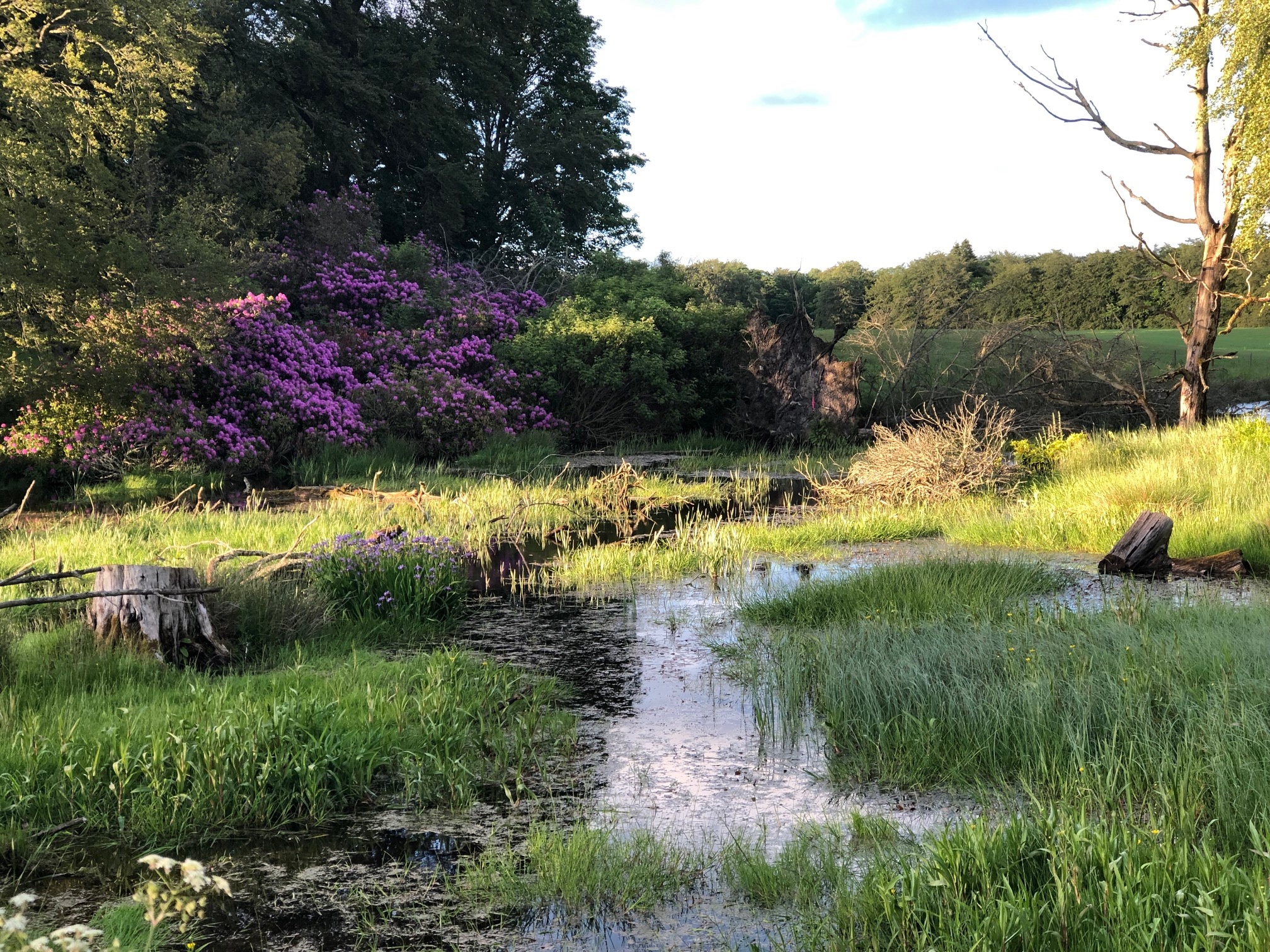
Arriving
“The more beavery the landscape is, the harder it is to find them.” This is what Laura Ogden, an environmental anthropologist from the US, told us on our first evening in Bamff in Perthshire as we took an evening walk to try to spot some beavers. An interdisciplinary group of ten researchers including artists, cultural geographers, and anthropologists, led by theatre-maker David Overend and human-geographer Jamie Lorimer, visited the estate for four days (June 20-23rd 2019) to explore “landscaping with beavers” and the possibility of multispecies collaboration. I was invited to participate as a performance-researcher due to my involvement in previous rewilding projects set up by Lorimer and Overend. In 2017 and 2018, Performing Wild Geographies workshops had taken place at the Knepp Estate in West Sussex (an ongoing project of rewilding discussed by one of the owners of the estate, Isabella Tree, in her book Wilding [2018]). These earlier projects aimed to explore “ecologies, performances, and conceptualisations of rewilding through a transdisciplinary collaboration” and Lorimer and Overend published a paper on the “Wild Performatives” which emerged from these investigations. The term wild performatives refers to “affective encounters with wildlife that make an intervention into the sphere of relations between human and nonhuman actors” (2018:2). Arriving in Bamff, we hoped to further develop our thinking in this area, exploring the shifts in the local landscape in the wake of the introduction of a keystone species – the beaver (castor fiber). This exposition reflects on what emerged from our transdiscipline experiments and what endeavouring to collaborate with more-than-human actants taught us about developing multispecies ecologies of practice. Here, I reflect on this collaborative project from my own perspective as artist-researcher and I have permission from the other artists involved to discuss and disseminate our shared work.

Our hosts were Paul and Louise Ramsay who own and run the estate in North-East Perthshire – 1300 acres of land made up of farmland, woodland, wetland and hills, including some ecotourism accommodation open to the public. For the past thirty years they have strived to restore a more natural environment to the area and have welcomed the return of various species of birds and mammals, most notoriously the Eurasian beaver. Beavers disappeared from Scotland in the 16th Century due to hunting and were reintroduced to the river in Bamff in 2002. Despite only being given protected status by the Scottish government in May 2019, the beavers have been breeding at the site since 2005. As the community has grown, they have extended their territory to create wetlands in between the fields and woodlands. The traces of the beavers’ activity are visible as soon as we arrive at the estate on a warm evening in June. Capsized trees with disks of roots exposed are the evidence of how the beaver’s dams are undermining the root structure of the trees, causing flooding. The Ramsay’s are keen to highlight the benefits that beavers bring to the land, with our host, Louise Ramsay, writing in Open Democracy: Beavers are a good thing. Not only are they a lost native species, part of our ecosystem, but they are a keystone species extraordinaire. […] The trees they cut often coppice abundantly later. Wetlands absorb agricultural run-off, mitigate flooding and drought, sequester carbon, and multiply biodiversity by providing habitat for invertebrates such as bees, amphibians, fish, wetland birds, otters, water voles and much else (2018). Beavers maintain basic water level during periods of drought and therefore provide an important resource for other wildlife. The impact that the beavers have had on the estate is evident and the marsh, wetlands and woods all bear the traces of beaver activity with many dams, felled trees and bark shavings around the site. We experience the longest day of the year on our visit; the light, warm evenings allow for late night encounters with the beavers as they go about their business of swimming, building, playing and eating.
The Critical Landscape
When considering the role of artistic research in articulating, unpicking, challenging and disrupting narratives of environmental crisis, performance studies is uniquely placed to reflexively and critically examine the current ecological context. Diana Taylor (2003) argues that performance does not only depict the “real” but has a role in actualising it too. In this way, these experiments in ecologies of practice – attempt to establish “reciprocal relationships with non-human creatures in the field” (Overend and Lorimer, 2018:3) – can not only provide generative encounters with the beavers but also disrupt the normative relations between human and more-than-human actants and “recode our relationship with wildness” (ibid:4). Performance-maker Sarah Hopfinger’s work Wild Life (2014-16) explored ideas of wildness with intergenerational human participants while companies such as Fevered Sleep also interrogate ideas of human/more-than-human relations through live and filmed performance.
Augusto Corrieri (2017) and Lisa Woynarski (2015) argue that theatre and performance must be reimagined beyond the current humanist anthropocentric framework. Woynarski posits what she calls ecological anthropomorphism – a non-anthropocentric performance aesthetic – as one strategy for decentering the human subject. Jane Bennett claims that we should cultivate some anthropomorphism – the idea that human agency has echoes in the more-than-human world – to challenge the idea that humans are at the top of the hierarchy (2010: xvi). Wallace Heim also critiques theatre as being solely dependent on the intensity of human-to-human relation[s] in the present (2018: 64), and Corrieri argues that only by questioning these anthropocentric dramaturgies and humanist traditions can we reorient performance and contest the idea that humans should occupy the leading role (2017:237).
Corrieri uses dramaturg Marianne Van Kerkhoven’s concept of minor and major dramaturgy to illustrate how we must move from examining the micro to the macro. Minor dramaturgy consists of the theatrical production and its audiences, which are easily grasped on a human scale while major dramaturgy encompasses everything beyond this, the theatre, the city, the world, the sea, the sky (2017:234). With ecological crisis already here (Morton, 2007) it seems urgent that the more-than-human elements of the world are justly considered and our work at Bamff aimed to realign these perspectives.
Arons and May argue that we share the same DNA gene pool with every other life form on earth and “despite our fantasies of human exceptionalism, [we are] always already a part of a collective of organisms” (2012:6). They admit that the most effective way to save the planet, from the perspective of the rest of its species, would be to eradicate humans altogether (2012:8). However, our rewilding research offers a more positive way of considering the role of the human (and particularly the artist) in developing cross-species collaborations. By attempting to displace the human subject from centre stage and entangling it (as it has always been) with its environment, and more-than-human kin (Haraway, 2016), performance can offer strategies for being ecological (Morton, 2018). These includes developing “ecologies of practice” (Christopher and Grodin, 2018), multi-species kinship (Haraway, 2016), and conceiving of performance as a form of ecology in action, what Lavery refers to as a form of “ecological doing” (2018:2).

Attending: “to be present at”
Some of us stay in the family home of the Ramsays (and are made to feel very much at home by their warm welcome and the sharing of food) and others take turns to stay solo in the “Hideaway”, a wooden building situated across from the beaver’s lodge where the beavers’ nocturnal activity can be witnessed. Those of us attending this research trip are here to explore the possibilities of collaborating with the beavers through interdisciplinary processes. I think of the word “attend”, meaning “to be present at”. Haraway’s 2016 study Staying With the Trouble outlines what we are facing in terms of ecological crisis; the “trouble” of the title. She contends: “staying with the trouble requires learning to be truly present, not as a vanishing pivot between awful or edenic pasts and apocalyptic or salvific futures, but as mortal critters entwined in myriad unfinished configurations of places, times, matters, meanings." (2016:1). This focus on present-ness, not just of being in attendance but attending to these questions of how to be truly present is vital. How to stay with the trouble, not run from it, ignore it or deny it, but to sit with it and ultimately to live with it are questions which feel urgent during our time at Bamff. One of the participants, cultural geographer Clemens Driessen, tells us that “for the animal, only the present exists” highlighting the different temporal modalities that we might need to consider when we are attempting collaboration with non-humans.
Another definition of “attend” is to deal with, cope with, or see to. This other meaning is also relevant as we try to find ways to take care of and give our attention to the beavers. Staying with the trouble is about attending to where we are now, acknowledging human’s “response-ability” (Haraway, 2016:115 – see also Haraway 2008): how we respond to what Tim Morton (and others) define as a period of mass extinction (2018). Sarah Hopfinger, reflecting on the previous Knepp experiments, claimed that some of the interventions “opened up a mode of attention – of attending – that is somehow slow, soft, curious, surprising, vulnerable, alert and perhaps, wild” (Overend and Lorimer, 2018:10). These multiple, unpredictable, complimentary and at times contradictory ways of attending to our more-than-human collaborators invoked an alertness and responsiveness in us as participants and within the ecology of our group.
Landscaping with Beavers
The aim of this workshop was to explore what sharing space and spending time with beavers adds to current approaches to performance practices within landscapes. The idea of mapping landscapes is explored by Shannon Rose Riley and Lynette Hunter in the introduction to their book of this name: “the performance structures of all research: as acts performed in particular locations and as highly performative acts that attempt to call forth the very thing they are invoking. By connecting arts and landscapes, we hope to show that how we know what we know is partly dependent on where we know” (2009: xx).
By working in the beaver’s environment, and in close proximity to them, we aimed to develop new ways of understanding them, becoming familiar with their landscapes and their behaviours. The ambition of the workshop was to engage with activities that would provoke interaction with each other, as artists, and with the beavers, as potential collaborators. The framework offered for this artistic experimentation was that of a cross-disciplinary field workshop situating researchers in a highly specific ecosystem in transformation. These sessions were framed as sensing, mapping and making and were led by different members of the group with different discipline specialisms.
I introduced the initial sensing session, encouraging participants to attune to the environment, attend to their senses and allow for an opening up to this place and what it had to offer. I asked people to use their animal instinct to find a spot to which they wished to respond. We started with a very human activity, writing, and from this we distilled our experience into a haiku, a short imagistic poem which takes place in the present, originally defined by Japanese poet Shiki as a “sketch from nature” (Ross, 2002: 12). These haikus were then translated into a live action, an embodied fragment of performance sited in our chosen spot. The responses to this task inviting participants to translate the written word into a physical action were varied: one participant sang an elegy while caressing a log, another cupped her hands in the water of the river then carried it to a tree to provide it with sustenance, one gave a lecture/litany about lichen, others used their bodies to explore the woods and the river bank while witnessed by others. I asked people not to view performance as a way of pretending or creating an artifice, instead, to invest in the real time/real effort mode of performance-making. Some used language, others song, while some remained silent. The varied responses reminded me of Riley and Hunter’s claim that “performance is always already boundless” (2009: 4) – that the opportunity for creative research through performance methodologies provides a plethora of outcomes and responses.
After my session designed to attune participants to the site and their own creative responses to place, David invited participants to explore the corporeal activities of the beavers. This included watching and also listening to them at play, “developing the hypothesis that beavers build by ear, following the sound of noisy water” as well as inviting more haptic responses such as “crawling, smelling, nibbling or even submerging themselves in the water” (Overend, 2019).
David’s invitation to us to “think like beavers” and to explore the landscape from a beaver’s perspective drew me immediately to the water. I sat by the beaver pools for a while and tried to get into this more-than-human frame of mind. I took off my hiking boots and dipped my toes in the still water. I felt repelled by the stagnant smell. My hand touched the bark of a tree and was coated in a sticky resin. I liked the smell of this, deep and foresty, but not the feel of it and I placed my hands in the dank water to try to wash it off. When we met back at the hideaway, David returned dripping water from his body after a swim in the beaver pools. He told us how he lay in the grass and followed a beaver path down to the water before slipping in, his body submerged among the water weeds. As David relayed his aquatic adventures, I felt disappointed that I had let my human sensibilities keep me on dry land. I hadn’t been able to put aside my revulsion of the brown brackish water, its icy-coldness, but I was glad to live vicariously through his telling of becoming beaver in those moments. As we share our explorations I have to confess that in my attempts to “become beaver”, I did have a little nibble of the furled back bark of a tree. It was horrible. Like the stagnant water, I could not move away enough from my human-ness to find it anything other than unpleasant. I am not a beaver. My teeth were not intended for this. But in attempting some beavery behaviour I felt I had a different understanding of my body in relation to theirs, of my own behaviours and drives alongside the beaver’s activities. I couldn’t feel this place as they did, but I felt as though I was beginning to see it through a different (more-than-human) lens. After this experience, I see them everywhere, not the beavers themselves, but their traces, marked indelibly in the landscape.

Making With
I carried Donna J. Haraway’s ideas of sympoiesis – of “making with” more-than-human others – with me throughout the weekend. What are we doing when we “make with” beavers? In viewing them as potential creative collaborators are we simply anthropomorphising them, this time as performance artists rather than architects, water managers or workers of the land? Do they want to “make with” us? What might the first steps in “making kin” (Haraway, 2016) be?
On the third day we spend the morning mapping as we explore the landscape of Bamff in more depth. Artist George Ramsay (who lives on the site) and Jamie (a geographer) led the session on mapping, where we began by looking at maps of the Bamff estate before venturing out to chart the site on foot, exploring the beaver dams, the “beaver deceiver” (a device used to divert water) as well as the way in which the landscape has been altered and marked by beaver activity and the hydrological impacts of the dams and flooded zones.
Further traces of the beavers’ activity become apparent as do the presence of other mammals, insects and birds. At one point we walk along the road between Bamff and its neighbouring farm. The road acts as a visual divide between two opposing ideas of land management. On the left, the neat, flat, familiar fields of green and yellow of a traditional agricultural farm. To the right, the tall, leafy, dark green trees of the Bamff estate loom above the road, swaying in the wind. The buzzards flying overhead seem to favour the airspace over Bamff.

The culmination of the workshop was the final making session which aimed to encourage multispecies collaboration, ways of “making with” the beavers. This activity was explored in three small groups and we made short site-responsive performance experiments which we shared on the final evening. For this making task, I worked with Jamie and Laura and we began by talking about building a dam. It was very tempting, but we came to the conclusion that attempting to imitate the beavers in this task was doomed to fail. When it comes to dam-building the beavers know best and we were concerned that in our ignorance we might end up disrupting their landscape or diverting water away from where they intended it to go. Would this be genuinely “making with”? Who says the beavers even want to make with us anyway? In our midsummer late night glimpses of them they had seemed ambivalent towards us at best.
We started thinking about how we might go about “making kin” with the beavers. On the first trip we had made to the beaver pools, we had noticed beaver artworks around the site. These sculptural forms, gnawed from tree trunks and the intricate interweaving of different natural materials within the structures of the dams, had made us consider the beavers’ endeavours not only as practical, but as creative and aesthetic too. Perhaps we could collaborate with these existing artworks to “make with” the beavers, to respond to something they had already produced: “If beavers are gifting us their art, then what are our obligations to them? (Ogden, 2019). Working with Laura for this task provided some context of the idea of gift-giving through the lens of anthropology. She states: “Gift exchange, as a social practice, requires us to be empathetic and open to another’s needs and desires” (2019). We thought that perhaps the first step to making kin could be offering some kind of gift to the beavers to help them with their endeavours.
We returned to the path by the beaver pools and realised that a small waterway at the end of the river which ran under the forest was the point of departure for beavers leaving the estate before moving out into the landscape beyond. We decided to mark this point of transition and decorated this passageway with an arch-shaped garland of the same pink flowers as the rhododendron bush at the beavers’ lodge. Jamie scratched on a slate the message “GO FORTH AND MULTIPLY” as we hoped the beavers would continue to thrive and breed beyond this boundary line which demarcated the safety of Bamff. We decided to frame these performative gifts as “OFFERINGS” and created a range of sited gifts for the beavers to encounter along the waterway. These included: a toolkit of materials that might be used to make a dam (“DIY”); some apple attached to various lengths of sticks hanging over the water for beavers to try to reach (“PLAY”); and some slices of apple arranged on a dock leaf under one of the beaver sculptures which we called “NIBBLES”. These small offerings to our beaver “oddkin” (Haraway, 2016) were placed along the river leading to the transition point and we thought of these as gifts they would receive as they made their way towards the passageway which led via water out of the Bamff estate. The signs that accompanied the stations were there for humans, to signify our intention with the specific gift, but the gifts themselves were designed with the beavers in mind (our hosts informed us that apples were a treat for beavers).

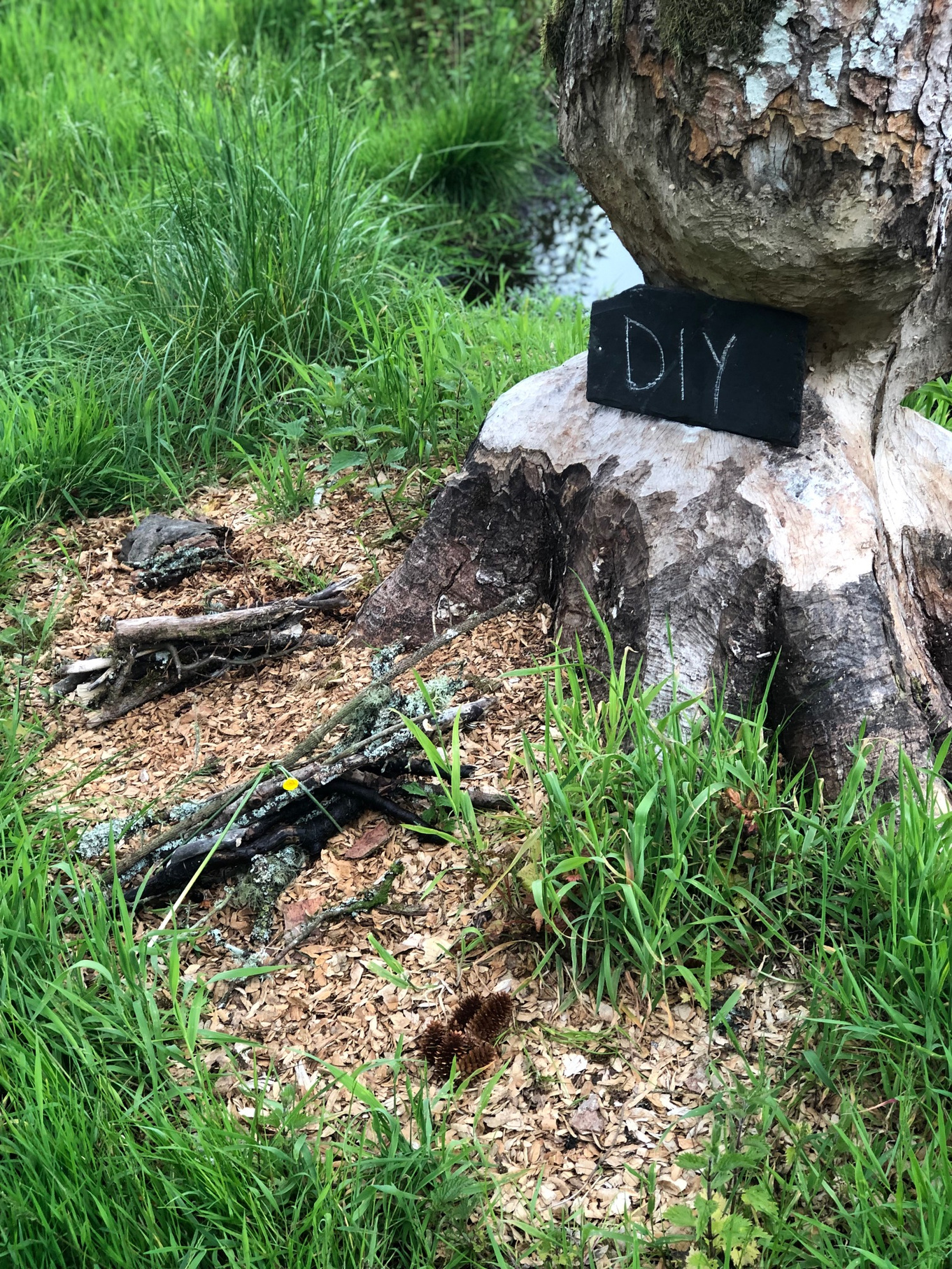
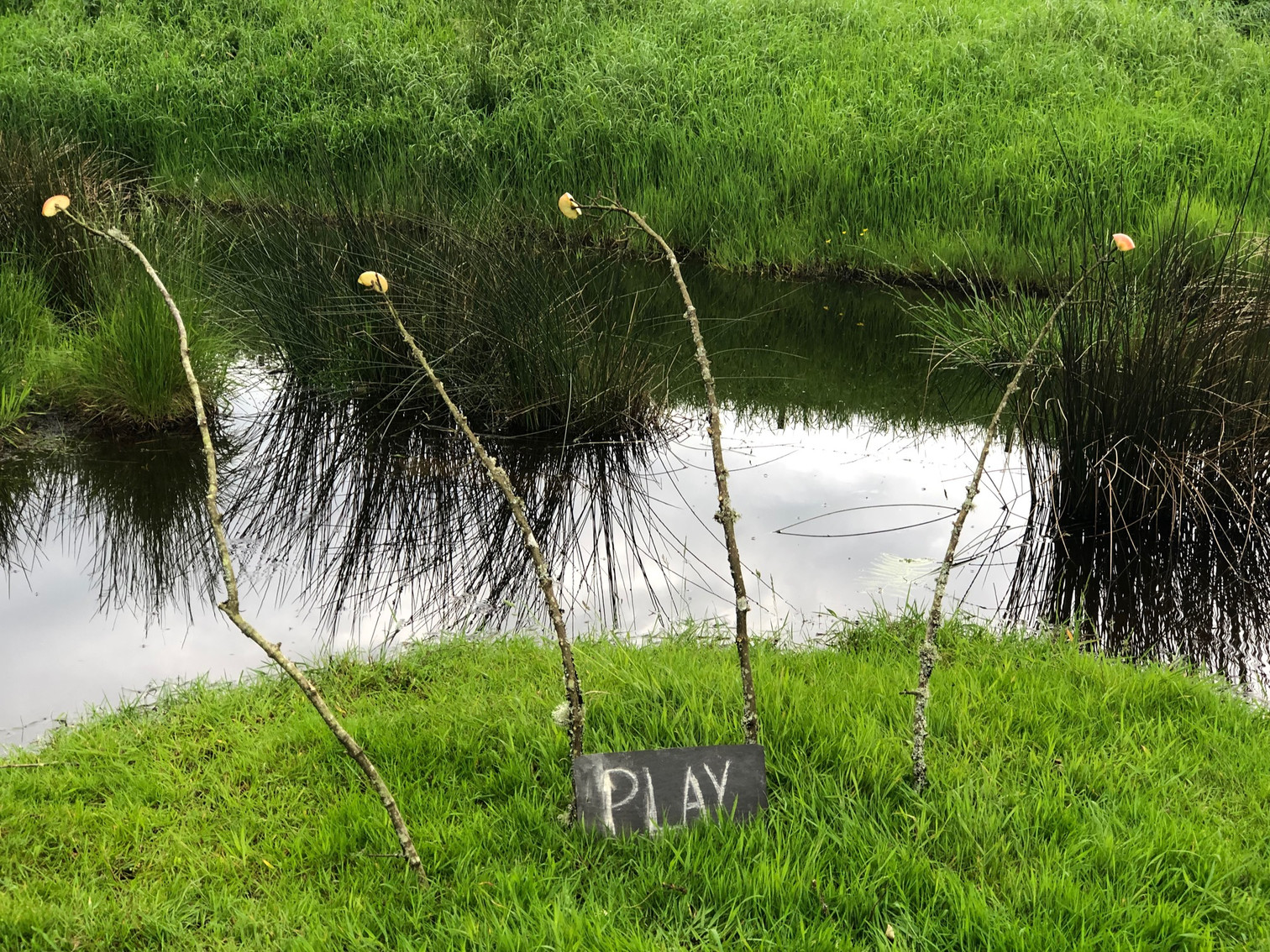
All ten participants devised collaborative performances for this final sharing, some of which included: a film of humans building a dam played on a laptop viewed through binoculars from the stairway of the hall in the Ramsay home; an audio track created by musician Scott Twynholm that layered a recording of the flow of water through a beaver dam as part of a one-to-one sound piece inviting audiences to sing a song to remember the dead; a live performance installation sited in the Steading and a solo guitar performance using a log to hit the strings as an audience member read out a recipe for beaver soup from an ancient tome. These varied and interdisciplinary responses speak to the creative possibility and “boundless” nature of contemporary performance practices.
Shannon Rose Riley and Lynette Hunter claim: If boundless specificity is one of performance’s crucial qualities, then a research methodology that plays on the insights created by paradoxes might match its complexities, especially when viewed from an ecological perspective that recognises its full interactivity with ‘context’ (2009:5). The range of responses to this site and its inhabitants was necessarily varied and this flexibility and flux in responding to our more-than-human collaborators and their environment provides an indication of the multiple ways in which performance research methods can open up this rich territory of multispecies collaboration within the specific context of rewilding sites. These experimental ecologies of practice attempted to establish “reciprocal relationships with non-human creatures in the field” (Overend and Lorimer, 2018:3) and began a process of reconsideration of the hierarchies between human and more-than human others and a recoding of our relationship with “nature”.
Our hosts accompanied us on a promenade performance of these performances throughout the estate on our final evening at Bamff; along with the beavers and other local wildlife they provided the audience for these experiments. The route ended at the boundary of the estate with our GO FORTH AND MULTIPLY sign. Louise explained to us that this was contentious in this context, that local farmers don’t want the beavers to go forth and multiply and the Ramsays themselves fear for the beavers’ safety once they are beyond the boundary of the estate. The beavers have no sense of the human division of land or the politics of land management but will instead move dependant on resources, environment and the presence of water. As we return to the house for a final dinner I feel closer to the beavers than I have before. I haven’t been physically proximal to one beyond the width of the river, but I feel like I can sense their way of being, their beaver-ness in a more intimate way by having spent time in their home.
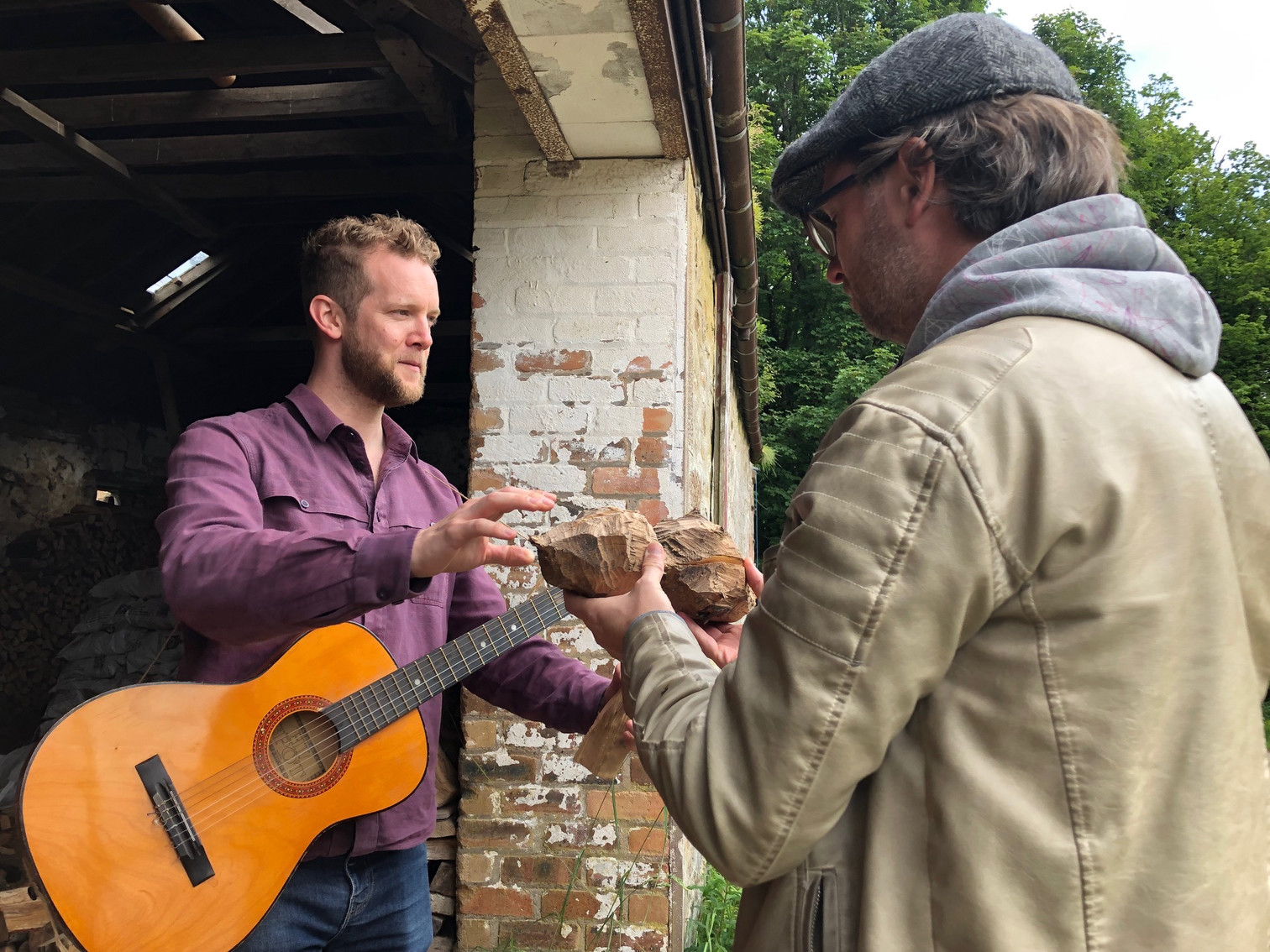
Traces
One of the main criticisms of conservation projects is that they are already an intervention into the natural processes of a site and its ecology. Rewilding projects face less of this critique as the ethos is often that of non-intervention, of “letting nature take its course”. However, some management and maintenance of a site is common and this can mean that there are some nuanced and at times conflicting interests between human and more-than-human actants. We began our journey at Bamff by noticing the impact of the beavers’ behaviours and the traces of their actions in the landscape. What would our traces on this place be? Mathew Reason in his article “Archive or Memory? The Detritus of Live Performance” (2003) asks how we can create an archive for performance, a medium that is ephemeral and live and which exists only in the moment. He says that all that is left behind are “husks” and proposes a theatrical archive of detritus. Inspired by this, and by the natural materials people had used in their performances, after our first day of making short performances in response to place, I asked participants to create a small archive of the “husks” that our actions have left behind. This archive existed for the duration of our time in Bamff then the materials were returned to the site. While the beavers’ traces are clear to see, it felt important that the traces we left on this place were not damaging or permanent. On the final morning when the group returned to the “OFFERINGS” installed the night before, some of the apple was gone from one of the lengths of stick hanging over the water. Described by Laura as “a bright moment of multispecies reciprocity,” our nocturnal kin had (perhaps unknowingly, reluctantly or ambivalently) accepted one of our invitations to play.
Conclusions
This initial interdisciplinary workshop exploring landscaping with beavers marks a beginning of how we might be able to develop interspecies collaborations. Our aim in working in the beaver’s environment, and in close proximity to them, was to develop a deeper and more attuned experience of their experience of this place. The collaborations were multiple, between us as a group of ten artists and academics, each with our own perspectives to bring to the process, and also, to attempt collaboration with the beavers. What we found out during our time at Bamff will be explicated further through a range of workshops at other sites of rewilding projects. The core team of Jamie, David and I have been awarded Royal Society of Edinburgh (RSE) funding to continue to develop these performative experiments alongside a range of rewilding projects, including a return to Bamff, working alongside Danielle Schreve in a cave at Ebbor Gorge and visiting the Oostvaardersplassen in the Netherlands with Clemens Driessen.
Artistic research can no longer function only on a humanist model (humans collaborating with humans on human issues). The continuing development of these transdisciplinary experiments into rewilding have already provided rich material suggestive of the possibility of making with and collaborating artistically with more-than-human actants. By thinking of these explorations as ecologies of practice, both the human participants’ processes of research and the beavers’ practices of transforming the landscape are held within the same physical space and the same conceptual landscape. By sharing space with the beavers, undertaking mimetic behaviour and embarking on artistic research with them, we have been offered a glimpse of the potential of cross-species communication and collaboration.
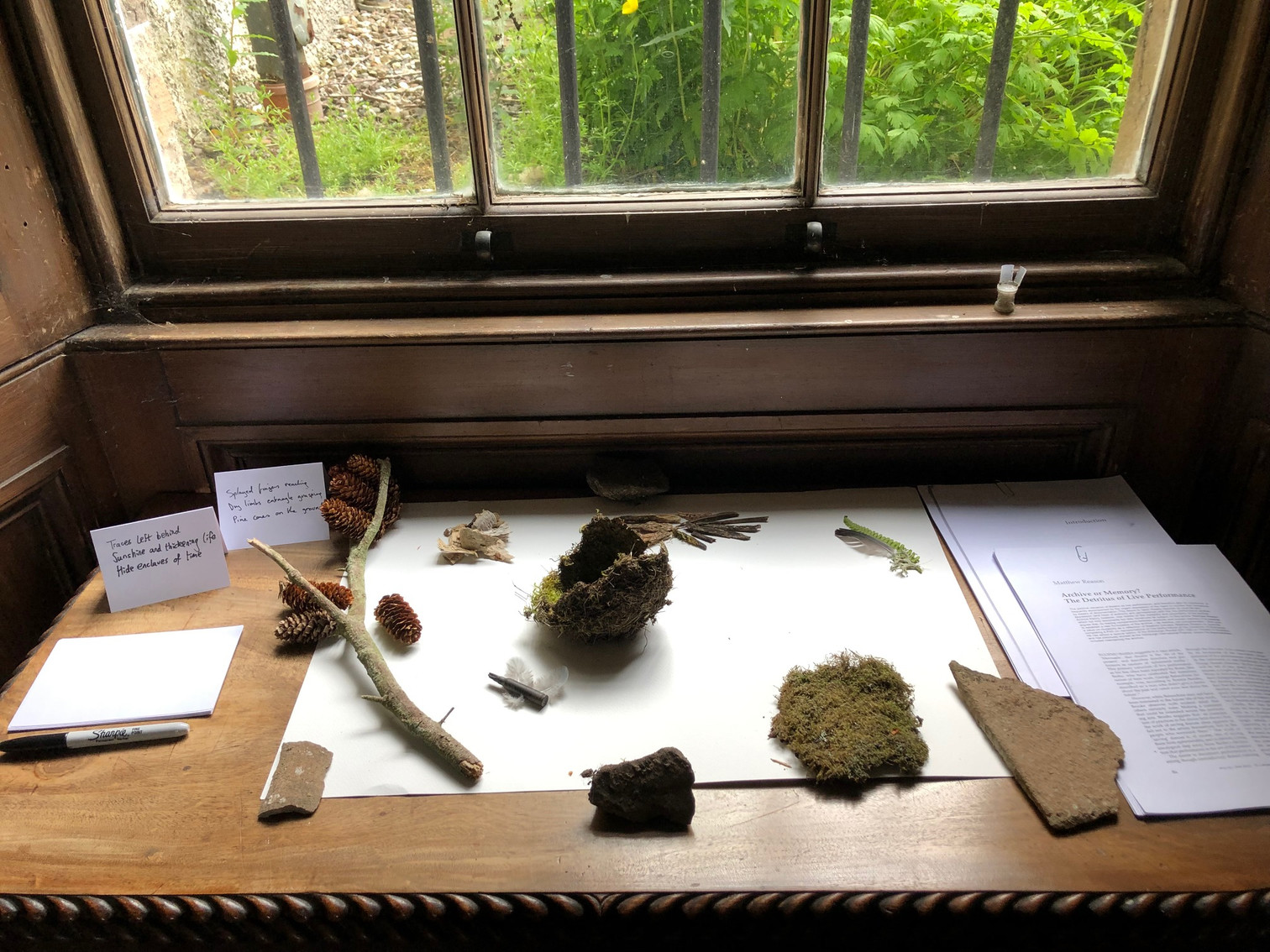
References
Arons, Wendy and Theresa J. May. 2012. Readings in Performance and Ecology. New York: Palgave Macmillan.
Bennett, Jane. 2010. Vibrant Matter: A Political Ecology of Things. Durham: Duke University Press.
Christopher and Grodin, 2018. “On creating a climate of attention: the composition of our work” In: Lavery, Carl (ed.) Performance and Ecology: What Can Theatre Do? London. Routledge.
Corrieri, Augusto. 2017. “The Rock, the Butterfly, the Moon, and the Cloud: Notes on Dramaturgy in an Ecological Age” In: Georgelou, Konstantina, Theodoridou, Danae and Protopapa, Efrosini (eds.) The Practice of Dramaturgy: Working on Actions in Performance. Valiz, Amsterdam.
Haraway, Donna, J. 2016. Staying with the Trouble: Making Kin in the Chthulucene. Durham: Duke University Press.
Heim, Wallace. 2018. “Theatre, Conflict and Nature” In: Lavery, Carl (ed.) Performance and Ecology: What Can Theatre Do? London. Routledge.
Lavery, Carl. 2016. “Introduction: performance and ecology – what can theatre do?” Green Letters Studies in Ecocriticism. Volume 20, Issue 3: Performance and Ecology: What Can Theatre Do?
Morton, Timothy. 2018. Being Ecological. London: Penguin Random House.
Morton, Timothy. 2007. Ecology Without Nature. Cambridge, MA: Harvard University Press.
Ogden, Laura. 2019. The Gift in the Beaver. Unpublished response to Bamff project.
Overend, David and Jamie Lorimer. 2018. “Wild Performatives: Experiments in Rewilding at the Knepp Wildland Project.” GeoHumanities, Volume 4, Issue 2.
Ramsay, Louise. 2018. “How Scotland’s beavers came back, and how you can help” https://www.opendemocracy.net/en/opendemocracyuk/how-scotlands-beavers-came-back-and-how-you-can-help/ accessed 26/03/20.
Reason, Matthew. 2003. “Archive or Memory? The Detritus of Live Performance” New Theatre Quarterly, 19:1, Cambridge University Press.
Riley, Shannon Rose and Lynette Hunter eds. 2009. Mapping Landscapes for Performance as Research: Scholarly Acts and Creative Cartographies. Basingstoke and New York: Palgrave Macmillan.
Ross, Bruce. 2002. How to Haiku: A Writer’s Guide to Haiku and Related Forms. Boston, Tuttle Publishing.
Taylor, Diana. 2003. The Archive and the Repertoire: Performing Cultural Memory in the Americas. Durham and London: Duke University Press.
Tree, Isabella. 2018. Wilding: The Return of Nature to a British Farm. London, Picador.
Woynarski, Lisa. 2015. “A house of weather and a polar bear costume: Ecological anthropomorphism in the work of Fevered Sleep” Performance Research, Volume 20, Issue 2: On Anthropomorphism.